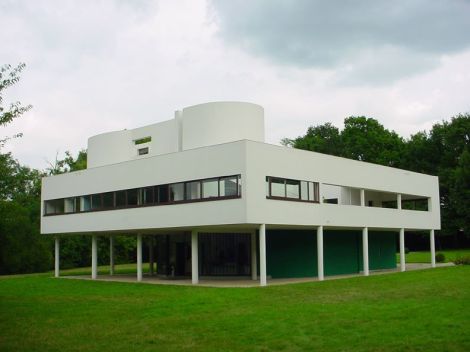
Villa Savoye, a seminal example of modern architecture designed by Le Corbusier. Completed in 1931. Photo by Wikipedia user Valueyou.
Years ago, in one of my first architecture courses, my classmates and I often found ourselves totally confused by a professor who only spoke using 14-letter words and philosophical metaphors that went WAY over our heads. One afternoon, while another student was presenting his work, this professor exclaimed something along the lines of, “NO! NO! NO! You’re attacking this design from the wrong paradigm! The house is a machine for living in!”
The next day, everyone had altered their designs to look like giant robot houses and we all got an earful of angry architecture theory that none of us understood with our measly 4-5 weeks of experience in architecture school. It didn’t take long to learn what he meant though because our professors referenced that phrase at least once a semester in every modern architecture history class, every theory seminar, and most of our design studios after that.
The phrase, “A house is a machine for living in,” rose to fame in the 1927 manifesto Vers Une Architecture (Towards An Architecture) by Le Corbusier. Rather than suggesting we all live inside robots or printing presses, it actually expresses that houses are tools we use to live and we happen to live inside them:
A house is a machine for living in. Baths, sun, hot-water, cold-water, warmth at will, conservation of food, hygiene, beauty in the sense of good proportion. An armchair is a machine for sitting in and so on.
By this definition, a house is an efficient tool to help provide for the necessities of life and no more. Decoration and extra frills are not necessary. He continues:
A society lives primarily by bread, by the sun and by its essential comforts. Everything remains to be done! Immense task! And it is so imperative, so urgent that the entire world is absorbed in this dominating necessity. Machines will lead to a new order both of work and of leisure.
Corbusier argued that by living in efficient house-machines we can be more productive and more comfortable. On top of that, he argued that the purely pragmatic products of engineering actually tend to be quite beautiful:
The Engineer, inspired by the law of Economy and governed by mathematical calculation, puts us in accord with universal law. He achieves harmony.
So if you’ve ever seen a stark, white, modernist home and wondered what the architect was thinking, now you can guess with some degree of certainty he intended the home to be a perfectly engineered tool for life.
Using this reasoning, Corbusier advocated an architectural style of simple shapes, clean lines, open floor plans, large windows, and comfortable furniture. Everything you need to live comfortably and productively and nothing more.
Although I can’t claim to understand with 100% certainty a man who single-handedly changed the course of architecture, I’d imagine Le Corbusier would be pretty impressed by iPhones as “machines for communicating.”
Every generation of the iPhone exemplifies the same kind of minimalist, functional design as Corbusier’s modernism. Comparing the first generation iPhone to other phones from the same year of release helps reveal that there is nothing superfluous to its design. Modernist homes and iPhones both have plenty of faults but they undoubtedly have played a large role in the history of design. Even though we tend to think of machines as cold, calculated instruments, they actually make our lives quite enjoyable.





Pingback: Annotated Bibliography | HANDE SIGIN·
Pingback: Le Corbusier’s Duplex: An architectural gem overlooking Stuttgart | KaSa Global Interiors·
Do not agree entirely with the starkness of this designer’s /design flow. Design must contain objects. (There, I’ve said it.)
LikeLike
Hmmm. Interesting. Can you give an example of something that is called ‘design’ but isn’t according to you because it doesn’t contain an object/objects? (Asking out of curiosity, not bad faith)
LikeLike
Pingback: 7 Bubble Tea Factory Moments that Resemble Art Works - Plural·
Pingback: Inside Lorin Roser’s New York Exhibition – Breaking World News·
Pingback: The Myth In The Machine: Inside Lorin Roser’s New York Exhibition -·
Pingback: Smart Homes und das Internet der Dinge – ZMMI – Das Magazin·
Pingback: UKRAINE. CAN THE RESTORATION INITIATE A NEW RENAISSANCE? – CONTINUED – POMIĘDZY SZTUKĄ A ŻYCIEM / BETWEEN ART AND LIFE·